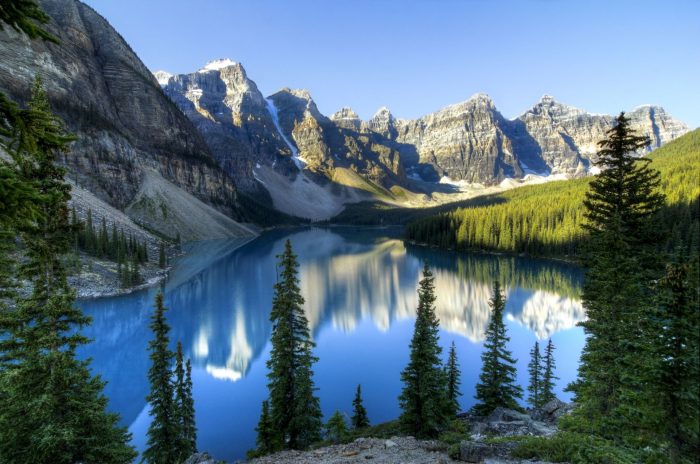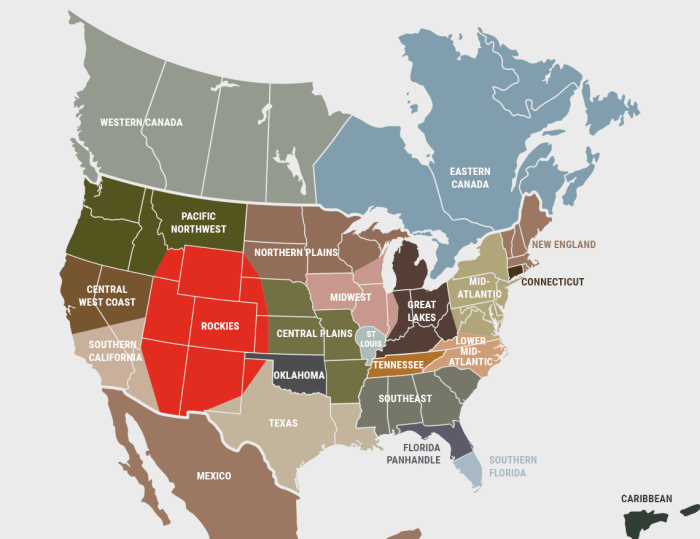Region east of the rockies crossword – Embark on an intellectual journey with our in-depth analysis of the region east of the Rockies, unraveling its geographical tapestry, historical significance, and cultural vibrancy. This exploration delves into the heart of this captivating region, providing a comprehensive understanding of its past, present, and future prospects.
From towering mountains to vast plains, from westward expansion to modern-day industries, the region east of the Rockies holds a wealth of stories waiting to be discovered. Its diverse population, rich heritage, and environmental challenges shape a dynamic and ever-evolving landscape.
Geographical Location

The region east of the Rocky Mountains encompasses a vast expanse of land in North America. It stretches from the eastern foothills of the Rockies to the Atlantic coast, encompassing a diverse array of landscapes and ecosystems.
The region is home to a multitude of states, each with its own unique character and history. These states include:
- Alabama
- Arkansas
- Connecticut
- Delaware
- Florida
- Georgia
- Illinois
- Indiana
- Iowa
- Kansas
- Kentucky
- Louisiana
- Maine
- Maryland
- Massachusetts
- Michigan
- Minnesota
- Mississippi
- Missouri
- Nebraska
- New Hampshire
- New Jersey
- New York
- North Carolina
- North Dakota
- Ohio
- Oklahoma
- Pennsylvania
- Rhode Island
- South Carolina
- South Dakota
- Tennessee
- Texas
- Vermont
- Virginia
- West Virginia
- Wisconsin
The region’s physical features are equally diverse. The eastern portion of the region is characterized by rolling hills and fertile plains, while the western portion is dominated by the rugged peaks of the Rocky Mountains. The region is also home to a network of major rivers, including the Mississippi River, the Ohio River, and the Great Lakes.
Historical Significance

The region east of the Rocky Mountains played a pivotal role in the westward expansion of the United States, serving as a gateway for pioneers and settlers seeking new opportunities and shaping the nation’s destiny.
Key historical events that transpired in the region include the Louisiana Purchase of 1803, which doubled the size of the United States and opened up vast territories for settlement; the Lewis and Clark Expedition of 1804-1806, which explored the region and established trade routes; and the California Gold Rush of 1849, which attracted thousands of fortune seekers and transformed the region’s economy and demographics.
Cultural and Economic Impact
The region’s rich history has profoundly shaped its present-day culture and economy. The diverse influences of Native American, European, and Asian immigrants have created a vibrant cultural tapestry, evident in the region’s art, music, and cuisine. The region’s agricultural heritage continues to play a vital role in its economy, with major industries including farming, ranching, and food processing.
Economic Profile

The region east of the Rockies boasts a diverse and robust economy, characterized by major industries such as agriculture, manufacturing, finance, and technology. Agriculture remains a significant economic driver, with the region being a leading producer of crops like corn, soybeans, and wheat.
Manufacturing is also a major contributor, with industries ranging from automotive and aerospace to pharmaceuticals and electronics. The region’s financial sector is centered in major cities like New York City and Chicago, and it plays a vital role in the global financial system.
Additionally, the technology industry has a strong presence in the region, particularly in areas like Silicon Valley and Boston.
Economic Strengths
The region’s economic strengths include its skilled workforce, advanced infrastructure, and access to major markets. The region is home to a highly educated population, with a large number of universities and research institutions. The transportation network is well-developed, with a dense network of highways, railways, and airports.
Additionally, the region’s proximity to major markets, both domestically and internationally, provides businesses with access to a vast consumer base.
Economic Weaknesses
Despite its strengths, the region also faces some economic challenges. One challenge is the high cost of living in many parts of the region, which can make it difficult for businesses to attract and retain workers. Additionally, the region’s manufacturing sector has faced competition from overseas in recent years, leading to some job losses.
Comparison to Other Regions
Compared to other regions of the United States, the region east of the Rockies has a relatively high level of economic development. The region’s GDP per capita is higher than the national average, and it is home to a number of major economic centers.
However, the region also has some areas of economic weakness, particularly in the manufacturing sector.
Cultural Diversity

The region east of the Rockies boasts a vibrant tapestry of ethnicities and cultures that have intertwined over centuries. From the bustling urban centers to the tranquil rural landscapes, the region’s cultural diversity manifests in its traditions, arts, and cuisine, shaping a unique and dynamic identity.
The region is home to a diverse array of immigrant communities, each contributing to the region’s cultural richness. These communities have preserved their traditions and languages, creating enclaves where cultural heritage thrives. At the same time, the region has witnessed the emergence of a distinct cultural blend, where different ethnicities and backgrounds have merged to create new traditions and expressions.
Cultural Traditions and Heritage
The region’s cultural heritage is reflected in its numerous festivals, celebrations, and traditions. Traditional dances, music, and costumes are showcased at events that bring together diverse communities. The region is also home to historical sites and landmarks that bear witness to its rich past, serving as reminders of the diverse cultures that have shaped its identity.
Arts and Music
The region’s cultural diversity has had a profound influence on its artistic expressions. Local artists draw inspiration from their cultural backgrounds, creating a vibrant and diverse artistic landscape. From traditional folk art to contemporary urban murals, the region’s art scene reflects the fusion of cultures that have come together in this region.
The region’s music scene is equally diverse, with influences ranging from traditional folk melodies to modern hip-hop. Local musicians often incorporate elements of their cultural heritage into their compositions, resulting in a unique and eclectic musical landscape.
Cuisine
The region’s cuisine is a testament to its cultural diversity. A blend of traditional dishes and international flavors, the region’s food reflects the diverse backgrounds of its population. Local restaurants offer a wide range of culinary experiences, from authentic ethnic dishes to innovative fusion cuisine that combines flavors from different cultures.
Environmental Challenges: Region East Of The Rockies Crossword
The region east of the Rockies faces several environmental challenges, including climate change, water scarcity, and air pollution. Climate change is already having a significant impact on the region’s ecosystems, leading to changes in temperature, precipitation patterns, and sea levels.
The region is also home to a number of major cities, which contribute to air pollution and water scarcity. The burning of fossil fuels in vehicles and power plants releases harmful pollutants into the air, while the withdrawal of water from rivers and aquifers can lead to water shortages.
Addressing Environmental Issues, Region east of the rockies crossword
The region is taking a number of steps to address these environmental challenges. These include:
- Investing in renewable energy sources, such as solar and wind power
- Improving energy efficiency in buildings and transportation
- Protecting and restoring forests and wetlands
- Reducing greenhouse gas emissions
- Improving air quality and water quality
These efforts are helping to reduce the region’s environmental impact and protect its natural resources for future generations.
Future Prospects

The region east of the Rockies possesses substantial economic growth potential. Its robust infrastructure, skilled workforce, and proximity to major markets provide a solid foundation for future development.
However, the region also faces challenges, including increasing competition from other regions and the need to address environmental concerns. To capitalize on its potential and mitigate these challenges, the region must focus on innovation, sustainability, and strategic planning.
Economic Growth Drivers
- Growing population and consumer base
- Expansion of technology and manufacturing sectors
- Investment in infrastructure and transportation
- Development of renewable energy sources
Challenges and Opportunities
The region faces challenges such as:
- Aging population and workforce
- Increasing healthcare costs
- Climate change and its impact on infrastructure and agriculture
However, these challenges also present opportunities for innovation and economic growth in areas such as:
- Healthcare technology and services
- Renewable energy and environmental protection
- Infrastructure development and resilience
Preparing for the Future
To prepare for the future, the region must:
- Invest in education and workforce development
- Promote innovation and entrepreneurship
- Implement sustainable practices to address environmental challenges
- Collaborate with neighboring regions and states
FAQ Resource
What states are included in the region east of the Rockies?
The region east of the Rockies encompasses a vast area, including the states of Montana, Wyoming, Colorado, New Mexico, Nebraska, Kansas, Oklahoma, Texas, and parts of North Dakota and South Dakota.
What was the significance of the region in the westward expansion of the United States?
The region east of the Rockies played a pivotal role in the westward expansion of the United States, serving as a gateway to the vast territories beyond. It was a hub for fur trading, exploration, and the establishment of settlements, shaping the course of American history.
How has the region’s history shaped its present-day culture and economy?
The region’s rich history has left an indelible mark on its present-day culture and economy. The influence of Native American tribes, European settlers, and westward expansion can be seen in its diverse cultural traditions, thriving agricultural industry, and modern-day industries.